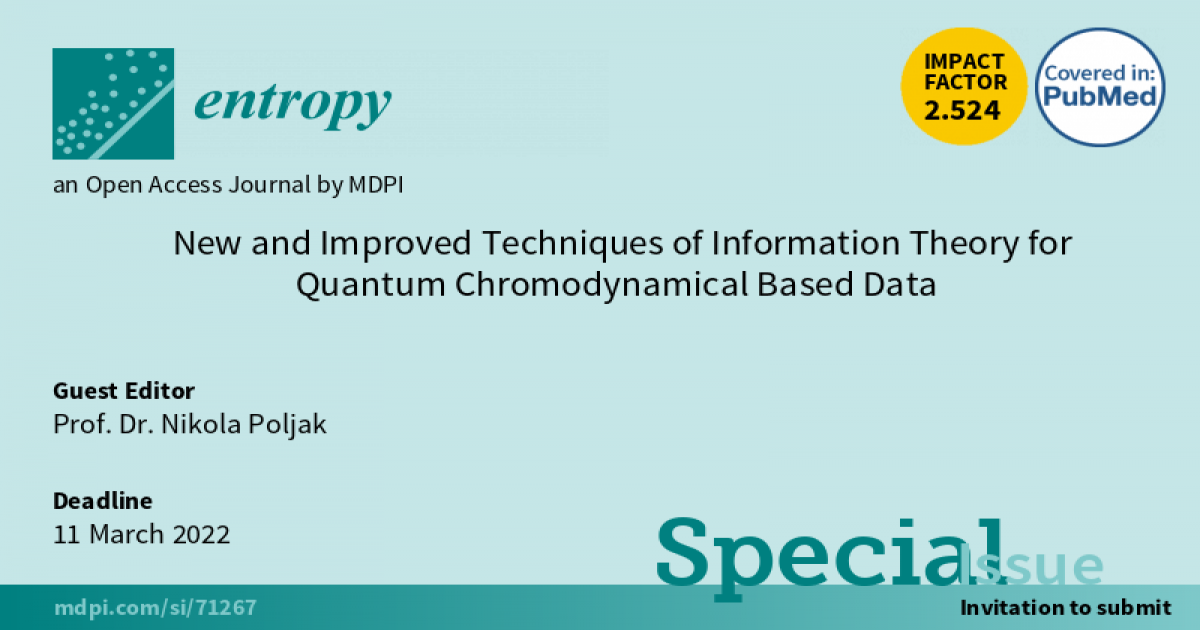New and Improved Techniques of Information Theory for Quantum Chromodynamical Based Data
A special issue of Entropy (ISSN 1099-4300). This special issue belongs to the section "Signal and Data Analysis".
Deadline for manuscript submissions: closed (11 March 2022) | Viewed by 2276

Special Issue Editor
Interests: quantum chromodynamics; LHC; interpretability; neural networks; machine learning; deep neural networks; network models; data analysis; educational physics
Special Issue Information
Dear Colleagues,
Our knowledge of the fundamental interactions of nuclei and the quarks and gluons that form them is summarized by Quantum Chromodynamics (QCD). Although our understanding of the theory is appreciable, the verification of it calls for experiments that operate at ever higher energies and intensities, which produce ever larger information-rich data samples. The analysis of these samples has seen a leap in the use of machine learning (ML) techniques in the last decade. The most common particle physics tasks making use of ML techniques are event selection, reconstruction and classification, usually combined in some way in an effort to look for rare events or new physical phenomena. This new approach, aided with our interpretation, greatly increases the discovery potential of present and future experiments.
We propose the use of ML techniques to look the other way – rather than look for new phenomena, try to understand what happens on a fundamental level in quark and gluon interactions. Since QCD, in its essence, is non-perturbative, we now use existing accelerator data to understand these interactions, implement them in simulations and then make further predictions. The use of ML techniques can be very helpful in this aspect, especially if experimental data are transformed into structures that can capture most important event characteristics, such as pixelated images of collision events represented in some manner. In combination with a wide range of already existing image classification algorithms, this approach may shed new light on basic QCD interactions.
This Special Issue aims to be a forum for the presentation of new and improved techniques of information theory for QCD based data - in particular, the analysis of collider data interpreted from a perspective of basic QCD constituents and interactions.
Prof. Dr. Nikola Poljak
Guest Editor
Manuscript Submission Information
Manuscripts should be submitted online at www.mdpi.com by registering and logging in to this website. Once you are registered, click here to go to the submission form. Manuscripts can be submitted until the deadline. All submissions that pass pre-check are peer-reviewed. Accepted papers will be published continuously in the journal (as soon as accepted) and will be listed together on the special issue website. Research articles, review articles as well as short communications are invited. For planned papers, a title and short abstract (about 100 words) can be sent to the Editorial Office for announcement on this website.
Submitted manuscripts should not have been published previously, nor be under consideration for publication elsewhere (except conference proceedings papers). All manuscripts are thoroughly refereed through a single-blind peer-review process. A guide for authors and other relevant information for submission of manuscripts is available on the Instructions for Authors page. Entropy is an international peer-reviewed open access monthly journal published by MDPI.
Please visit the Instructions for Authors page before submitting a manuscript. The Article Processing Charge (APC) for publication in this open access journal is 2600 CHF (Swiss Francs). Submitted papers should be well formatted and use good English. Authors may use MDPI's English editing service prior to publication or during author revisions.
Keywords
- machine learning
- quantum chromodynamics
- quark/gluon separation
- image classification
- data representation
- distribution functions
- interpretability






